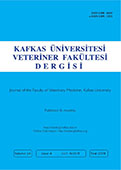
This journal is licensed under a Creative Commons Attribution-NonCommercial 4.0 International License
Kafkas Üniversitesi Veteriner Fakültesi Dergisi
2018 , Vol 24 , Issue 4
Helminths That Are Detected by Necropsy in Wrestling Camels
1Adnan Menderes University, Faculty of Veterinary Medicine, Department of Parasitology, TR-09020 Efeler/Aydin - TURKEY2Uludag Integrated Meat Facilities, Umurlu Mh. TR-09630, Efeler/Aydin - TURKEY DOI : 10.9775/kvfd.2018.19591 The present study aims to carry out a helminthological examination and epizootiological determination of the parasites that were detected by the parasitological examination in the carcasses and internal organs of wrestling camels that were slaughtered due to miscellaneous reasons. The material of the study comprised wrestling camels that were sent to the slaughterhouse for various reasons including sickness, old age, and underperformance due to an unknown cause. The present study was conducted on 24 male wrestling camels of ages ranging between 5 to 20 years. After slaughtering, the carcasses and internal organs were examined parasitologically. All internal organs, except for abomasum and intestines, were macroscopically analyzed in the slaughterhouse to determine whether any helminth larvae or adult helminths were present and those that bore traces of a parasitic period were brought to the laboratory for further analysis. For the examination of the digestive system, abomasa, and intestines, along with their contents, were brought to the laboratory to perform macroscopic and microscopic analyses by following appropriate methods. At least one helminth infection was seen in 14 (58%) of 24 camels in necropsy. The analysis of the organs revealed hydatid cysts in 12 (50%) animals, which were localized in the lungs of 7 animals, livers of 3 animals, both in the lung and liver of one animal and in the spleen of another animal. By examining the stomachs and intestines of the animals, Stilesia globipunctata was detected in the small intestines of 3 camels (12.5%), while Nematodirus filicollis was detected in the small intestine of one animal (4.1%), and Oesophagostomum venulosum was detected in the large intestine of the same animal (4.1%). Neither helminth larvae nor adult helminths were observed in other organs. The presence of hydatid cysts in over fifty percent of the examined camels is noteworthy. As a disease of great importance for public health, its prevalence in camels brings forth the absolute requirement for slaughtering animals in slaughterhouses or under the control of a veterinary physician. This study is the first one to report the occurrence of Stilesia globipunctata, Nematodirus filicollis and Oesophagostomum venulosum in camels at species level. Keywords : Camel, Helmint, Hydatid cyst, Necropsy, Turkey










